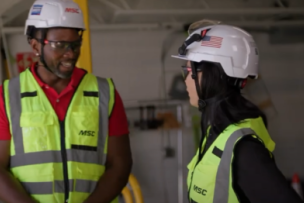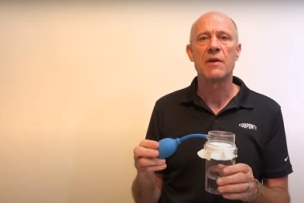The National Institute for Occupational Safety and Health’s (NIOSH) theme for “N95” Day this year is “The Science behind Respirator Fit Testing in the Workplace: Past, Present, and Future.” What might not be known is that 3M has been applying fit test science to respirator wearers’ life for years. 3M even pioneered the creation of the saccharin qualitative fit test protocol – the first qualitative fit test for filtering facepiece respirators based on taste of a test agent.
A fit test is a technique using either a qualitative or quantitative protocol to evaluate sealing-surface leakage of a specific tight-fitting respirator while worn by an individual.1 A qualitative fit test (QLFT) is a fit test that relies on the wearer’s sensory response to detect the test agent. In order to evaluate sealing-surface (face-seal) leakage only, it is important that the fit test method does not allow significant filter penetration because the test agent coming though face-seal leaks or through the filter cannot be differentiated from each other by the measuring instrument or the wearer. This means that careful consideration needs to be given to the selection of a test agent for the respirator being fit tested. It must be able to identify face-seal leaks while not penetrating through the filter and be detectable (e.g., smell or taste) by the wearer.
The Saccharin Solution Aerosol Method was developed by 3M in the early 1980s so that an accurate QLFT method would be available that did not require the use of respirators that were probed or had filters other than the particulate filter used by employees. For example, standard quantitative fit testing (QNFT) requires the use of probed high-efficiency respirators instead of N95 filters that may actually be used in the workplace.



Talk to Us!
is fit testing required for users of Disposable N95 respirators?
What is the recommended method to fit test Disposable N95 respirators? What is the least expensive (in terms of cost of equipment to run the test)?
21Hi Roel,
That's a great question. In light of all the COVID-19 issues and N95 shortages, we have seen some pretty interesting applications of respirators, both good and bad. I have even noticed the public using respirators incorrectly, by doing things like covering only their mouth, wearing the respirator loosely and donning with facial hair, all behaviors which could potentially expose the wearer to hazards.
According to OSHA 1910.134(f) -
"1910.134(f)
Fit testing. This paragraph requires that, before an employee may be required to use any respirator with a negative or positive pressure tight-fitting facepiece, the employee must be fit tested with the same make, model, style, and size of respirator that will be used. This paragraph specifies the kinds of fit tests allowed, the procedures for conducting them, and how the results of the fit tests must be used."
Here are some kits from 3M you can use:
https://www.mscdirect.com/browse/tn/?searchterm=3m+fit+test+respirator&hdrsrh=true
Here is a video explaining the process:
https://www.osha.gov/video/respiratory_protection/fittesting.html
The article above explains the fit testing requirements as well.
One piece to note is that the spirit of these requirements is to prevent contaminants from entering the lungs. If there are gaps anywhere in the fit of the respirator or the respirator does not perform its function, it most likely will not work to protect the individual and protection is the ultimate goal. So, how we protect is just as important as with what we protect.
24Leave a reply
Your email address will not be published. Required fields are marked *